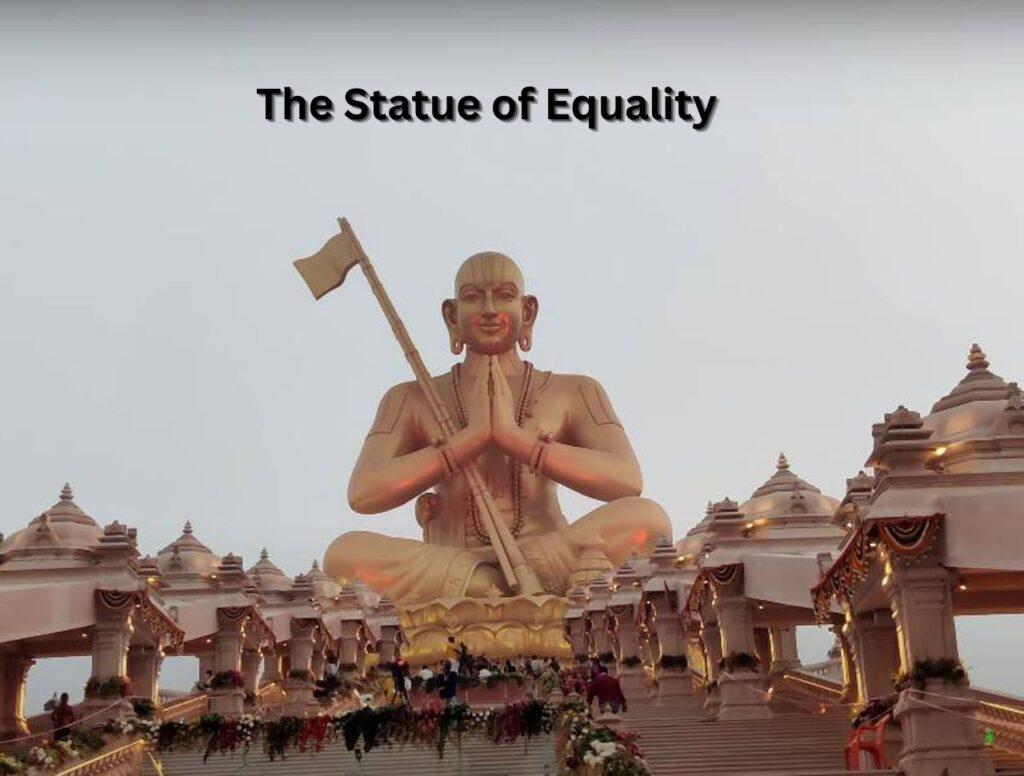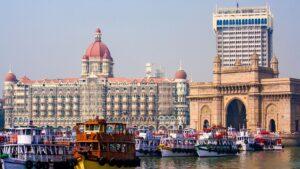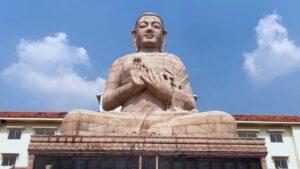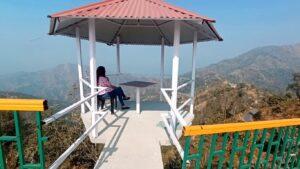The Statue of Equality is a monumental tribute to the 11th-century Hindu philosopher and saint Ramanuja, who preached the message of equality and universal brotherhood. The statue is located on the premises of the Chinna Jeeyar Trust at Muchintal, Ranga Reddy district on the outskirts of Hyderabad. It is the world’s tallest statue of Ramanuja, standing at 216 feet (66 meters) high. The statue is part of a larger complex that includes a temple, a museum, a library, a meditation hall, and other facilities. We will guide you with some information on the Statue of Equality, such as its timings and opening hours, tickets and distance from the nearest cities, and events.
About The Statue of Equality
The Statue of Equality was built to commemorate the 1000th birth anniversary of Ramanuja, who was one of the most influential thinkers and reformers in Hinduism. He advocated the concept of Vishishtadvaita or qualified non-dualism. Ramanuja also challenged the caste system and promoted the inclusion of all people in worship and service to God. He established 74 centers of learning and worship across India and wrote many works on philosophy, theology, and ethics.
The Statue of Equality is a symbol of Ramanuja’s teachings and a reflection of his grandeur and grace. The statue is made of panchaloha, a five-metal alloy of gold, silver, copper, brass, and zinc. It is mounted on a 54-foot-high base building named Bhadra Vedi. The ground floor depicts the life and philosophy of Ramanuja through exhibits and audio-visuals. A temple dedicated to Ramanuja occupies the second floor, where devotees perform daily worship. A Vedic library and research center houses ancient Indian texts and manuscripts on the third floor, where scholars preserve and study them.
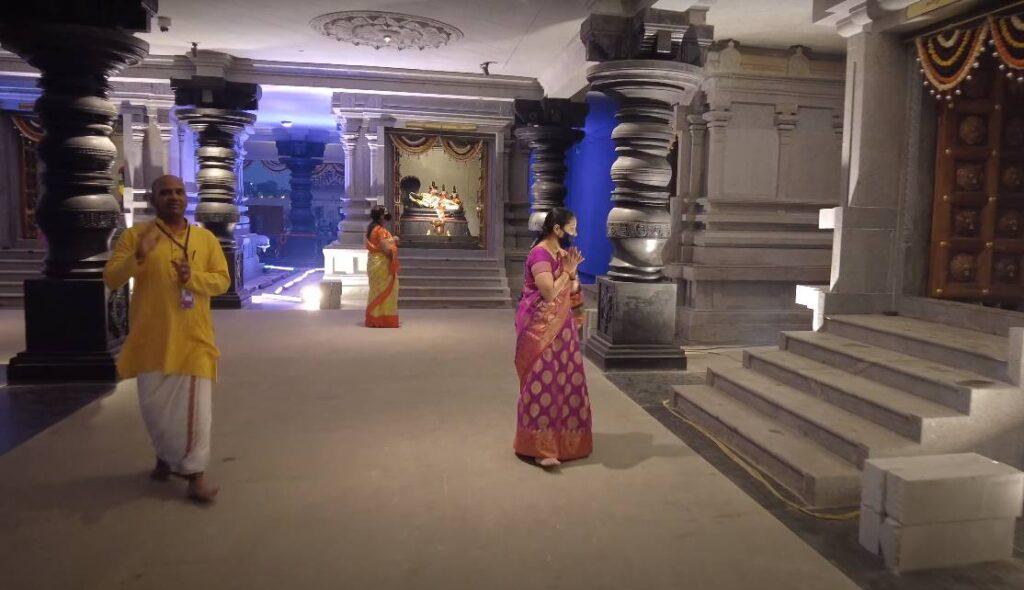
The complex also features 108 Divya Desas, or sacred shrines of Vishnu, which inspired Ramanuja in his spiritual journey. Saligrama murtis (fossilized shell stones) depict Vishnu’s forms in Divya Desas. They bring the murtis from the original temples across India. Then they install them in the complex with due respect and rituals. Visitors can have a darshan, or a glimpse, of these murtis and learn about their significance and history.
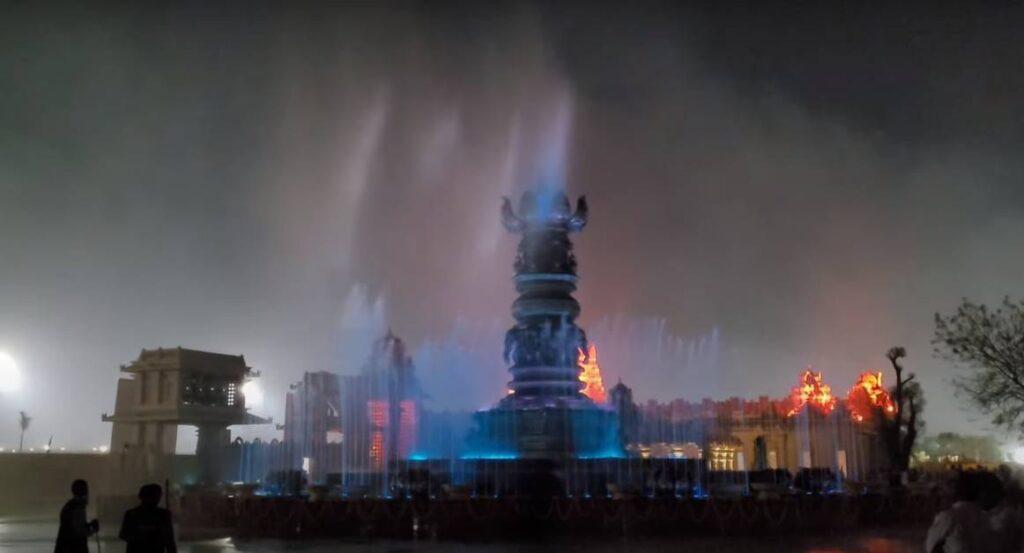
Another attraction in the complex is the Leela Jala Neerajanam or the dancing water show with lights and music. Fountain show: water, lasers, projections, sound. Ramanuja’s life and teachings. The show is held daily at 1:00 PM, 4:00 PM, 7:00 PM, and 8:30 PM. Visitors can enjoy this show from a viewing gallery or the steps leading to the statue.
Opening Hours and Tickets: The Statue of Equality
The Statue of Equality is open from 11:00 AM to 8:00 PM on Monday, Tuesday, Thursday, Friday, Saturday, and Sunday. It is closed on Wednesday. There is a small break from 4:00 p.m. to 4:30 p.m. when visitors are not allowed in.
The entry fee is INR 200 for adults and INR 125 for children between 5-12 years. The ticket price includes INR 50 per head for the Dynamic Fountain Show, which is a spectacular water show with lights and music that depicts the life and teachings of Ramanuja.
You can save time and money by booking your entry passes online in advance. Look for coupons or discounts on various websites or apps that offer deals on attractions in Hyderabad. Visit during off-peak hours or seasons to avoid crowds and enjoy a more peaceful experience.
Distances from the Nearest Cities to The Statue of Equality
The Statue of Equality is located in Sriram Nagar on Hyderabad – Muchintal Road. It is about 17 km from Hyderabad city center, 38 km from Shamshabad airport, and 40 km from Secunderabad railway station. You can reach the statue by car, bus, train, or taxi.
By car: You can drive to the statue by taking the Outer Ring Road (ORR) from Hyderabad or Shamshabad and exit at Exit No. 14 (Kollur). Then follow the signboards to reach the statue. The car parking fee is INR 40.
By bus: You can take a bus from various points in Hyderabad or Secunderabad to Kollur Cross Road or Kollur Bus Stop. Then you can take an auto-rickshaw or walk for about 2 km to reach the statue.
By train: You can take a train from Secunderabad or Hyderabad to Nagulapalli railway station. Then you can take an auto-rickshaw or taxi for about 10 km to reach the statue.
By taxi: You can book a taxi from any location in Hyderabad or Secunderabad to the statue. The fare may vary depending on the distance and traffic conditions.
Weather and Climate: The Statue of Equality
The weather and climate of Hyderabad, where the Statue of Equality is located, vary throughout the year. The city has a tropical wet and dry climate with four seasons: summer (March to May), monsoon (June to September), post-monsoon (October to November), and winter (December to February).
Summer: This is the hottest season in Hyderabad with temperatures ranging from 24 °C (75 °F) to 40 °C (104 °F). The heat can be unbearable for some visitors, especially during April and May. However, this is also the time when you can see some colorful flowers blooming around the statue.
Monsoon: This is the rainy season in Hyderabad with rainfall ranging from 110 mm (4.3 inches) to 205 mm (8.1 inches) per month. High humidity and occasional floods can affect the roads. However, this is also the time when you can see some greenery around the statue and enjoy the cool breeze.
Post-monsoon: This is a transition season in Hyderabad with moderate temperatures ranging from 21 °C (70 °F) to 32 °C (90 °F). The rainfall decreases gradually and the sky becomes clear. This is a good time to visit the statue as the weather is pleasant and comfortable.
Winter: This is the coolest season in Hyderabad with temperatures ranging from 15 °C (59 °F) to 30 °C (86 °F). The nights can be chilly and foggy at times. However, this is also the time when you can see some festivals and events taking place around the statue.
Events and Festivals: The Statue of Equality
There are some events and festivals that take place in or around the Statue of Equality throughout the year. Some of them are:
Equality Day: This is a day to celebrate the message of equality and universal brotherhood that Ramanuja taught. People observe this day on April 1, which is the birth anniversary of Ramanuja. On this day, they organize various programs and activities at the statue, such as cultural performances, speeches, prayers, and more.
Sri Ramanujacharya’s Jayanthi: People commemorate the birth of Ramanuja, one of the greatest saints and philosophers in Hinduism, on this day. It falls on the full moon day of the month of Chaitra, which usually occurs in April or May. On this day, they perform special rituals and ceremonies at the temple dedicated to Ramanuja at the statue.
Diwali: This is one of the most popular festivals in India, which celebrates the victory of light over darkness and good over evil. People celebrate it on the new moon day of the month of Kartika, which usually falls in October or November. On this day, they illuminate the statue and the complex with lights and lamps, creating a festive and colorful atmosphere.
The Statue of Equality on the outskirts of Hyderabad is a must-visit destination for anyone who wants to experience the beauty and wisdom of Ramanuja’s legacy. It is not only a marvel of art and engineering, but also a source of inspiration and enlightenment for generations to come. You can visit the statue at any time of the year, depending on your preference and convenience. We hope you enjoy your visit to the Statue of Equality and have a memorable time.
